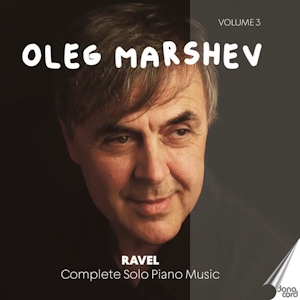
Maurice Ravel (1875-1937)
Complete Solo Piano Music Volume 3
Valses nobles et sentimentales (1911)
Le Tombeau de Couperin (1914-1917)
À la manière de Chabrier (1912-1913)
À la manière de Borodine (1912-1193)
La Valse (1920)
Prélude (1913)
Fugue in B flat major (1902)
Oleg Marshev (piano)
rec. 2023, Cultural Institute, Milan, Italy
Danacord DACOCD905 [77]
This is the final instalment of Oleg Marshev’s authoritative account of the complete solo piano music of Maurice Ravel. Volume 1 is reviewed here, Volume 2 here.
The title Valses nobles et sentimentales alludes to Franz Schubert’s two sets of dances from the 1820s, Valses nobles D969 and Valse sentimentales D799. As Ravel said, that signalled “clearly enough my intention to write a chain of valses in the style of Schubert”. The score was prefaced by a quotation from the French symbolist poet, Henri de Regnier: “…le plaisir délicieux et toujours nouveau d’une occupation inutile” (…the delectable and always novel delight of a useless pursuit).
In contrast with the high virtuosity of the 1908 Gaspard de la nuit, the cleaner style of the Valses emphasised harmonies and brought them into focus. That does not make these eight waltzes easy. The liner notes say that Ravel may also have been inspired by the “discovery of Liszt’s Valse caprice after Schubert and his Soirées de Vienne”’, and there are echoes of Johann Strauss II in the fourth and seventh number. This is simply a series of seven sparkling waltzes with an epilogue which seductively reprises previously heard tunes.
Le Tombeau de Couperin (The Tomb of Couperin) was a wartime work completed by 1917, after Ravel had been demobilised. He described it as “a tribute not so much to Couperin himself as to Eighteenth Century French music in general”. The movement titles are like those Couperin and his contemporaries used.
Despite its milieu, this collection is neither sad nor elegiac. The fast-flowing Prelude has relentless semiquaver triplets and interpolated mordents. In the Fugue, less inspiring, the voices unfold gently. It has been described as static but Oleg Marshev makes it as magical as possible. The appealing but over-long Forlane in 6/8 time has dotted rhythms, innovative ornamentation and reflective harmonies. A bright and breezy Rigaudon balances a chromatic middle section with more diatonic opening and closing paragraphs. Minuet, according to the liner notes, is “a piece of fairy-princess, Mother Goose escapism” offset by a primitive “musette” which hints at the Dies irae from the Requiem Mass. The Toccata looks back to the opening Prelude with its virtuosic figurations. Each movement was dedicated to the memory a friend killed in the fighting.
À la manière de Chabrier and À la manière de Borodine commemorate two composers whom Ravel had always admired. The Chabrier is a paraphrase of the Flower Song from Gounod’s Faust. It has been described as “astonishingly faithful” and as a “mimicry”. The Borodin presents a waltz “loosely based on themes from the Russian’s Petite Suite and the scherzo from his String Quartet No.3. It is a little more serious in temper with “flowing, colourful harmonies.”
Not all commentators have been enthusiastic. Norman Demuth wondered “why [Ravel] parodied Chabrier by means of a paraphrase of a song from Gounod’s Faust” and that in sum, both pieces are “utterly useless”. They are played here without condescension.
The short Prélude was a sight-reading exercise for a competition at the Paris Conservatoire. It was dedicated to the winner, Jeanne Leleu. For such a tiny number, it has a great depth of sadness, and there are a few technical snags to overcome.
I have always felt uneasy listening to La Valse – be it the orchestral or the piano version. The heading of the score reads: “Through the swirling clouds waltzing couples may be seen. One by one the clouds vanish; a huge ballroom filled by a circling mass is revealed […]”. Even so, I find it menacing. This “symphonic waltz” has many of the stylistic feature of its model, the Viennese waltz. The one thing that it lacks is the gaiety. Is this a celebration or is it a parody? Does Ravel intend to deconstruct the form and suggest the downbeat mood of post-war Vienna? The fierce climax of La Valse is a million miles away from the vivacity of a ballroom in the Second Empire. The whirling motions of the dancers leads to death and annihilation. There is much in these pages that is beguiling and even beautiful, but it seems to me that Ravel has destroyed the Viennese waltz for ever. The piano solo version, extremely successful, demands a virtuoso technique. It gets a stunning rendition here.
There is nothing wrong with the Fugue in B flat major. (It was Ravel’s entry in the 1902 Prix de Rome, unpublished until 2009, when it appeared as an appendix in Stephen Zank’s Irony and Sound: The Music of Maurice Ravel.) Such academic exercises demands an airing from time to time. I just would not have make it the last track on the last disc in this cycle. Perhaps the wonderful Le Tombeau de Couperin should have brought the proceedings to a conclusion.
The recording is at times a little bright and hard-edged. Peter Quantrill’s liner notes (from which I have quoted, with thanks) give helpful information about all the pieces except the Fugue. There is a recap of Oleg Marshev’s career; more details can be found here. Once again, I must comment on the less-than-flattering cover photograph. It feels sinister and does nothing to compliment this fine recital and the highly imaginative repertoire.
The excellent performance captures all the nuances of Ravel’s pianism which encompasses impressionism, romanticism and the work of the French clavecinists. Marshev consistently uncovers the excitement, the beauty and the formal structures of this music.
John France
Help us financially by purchasing from



















